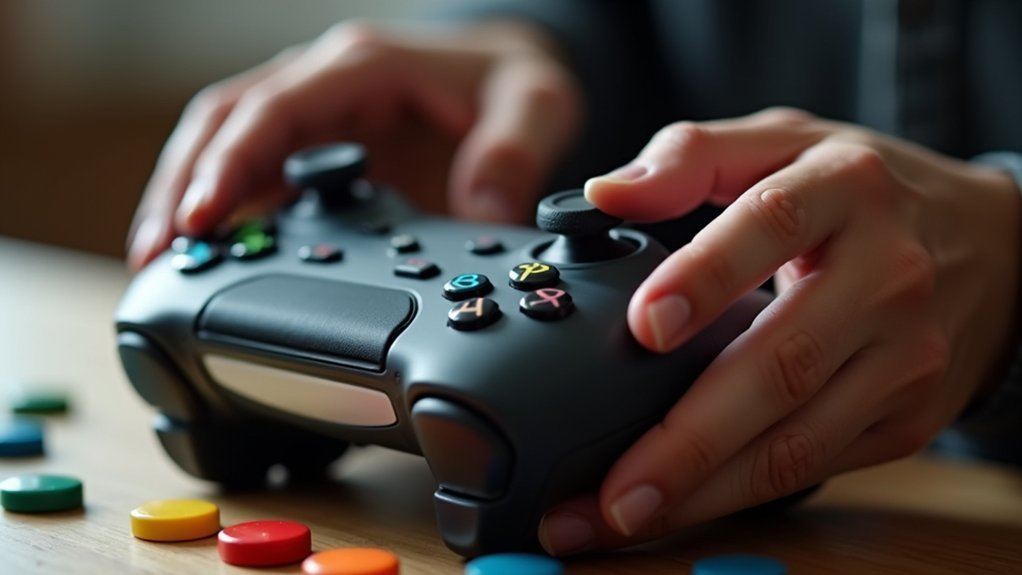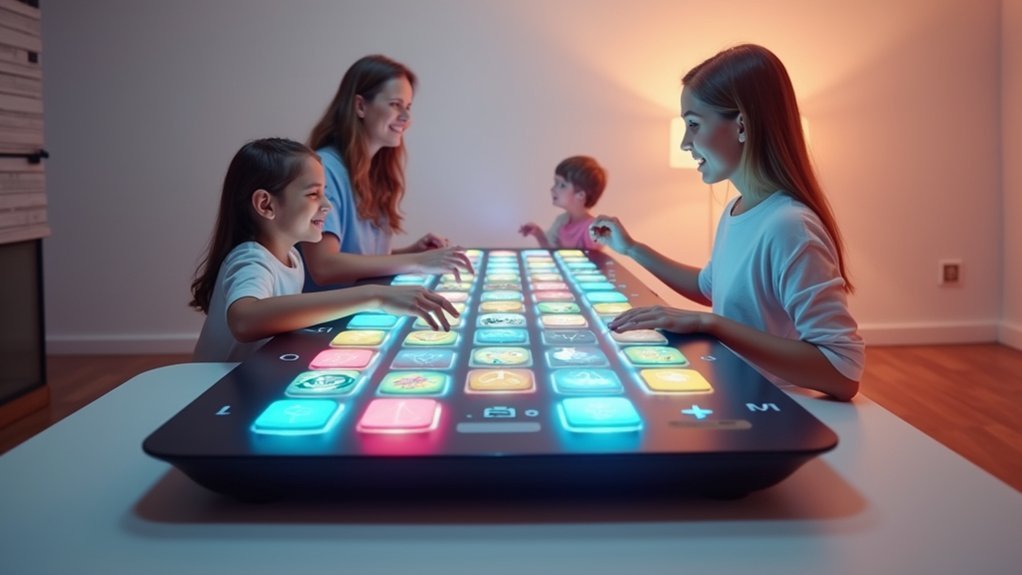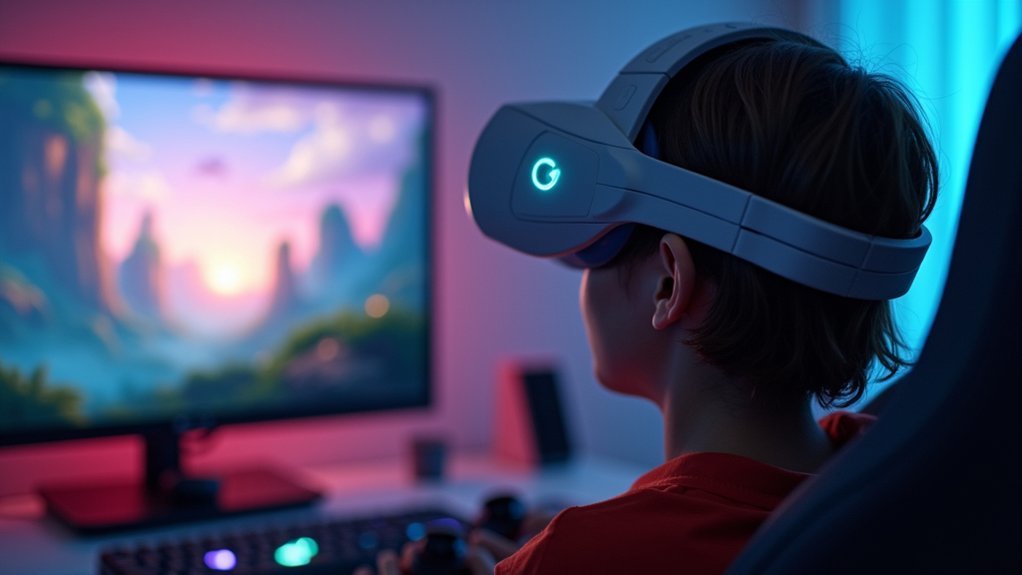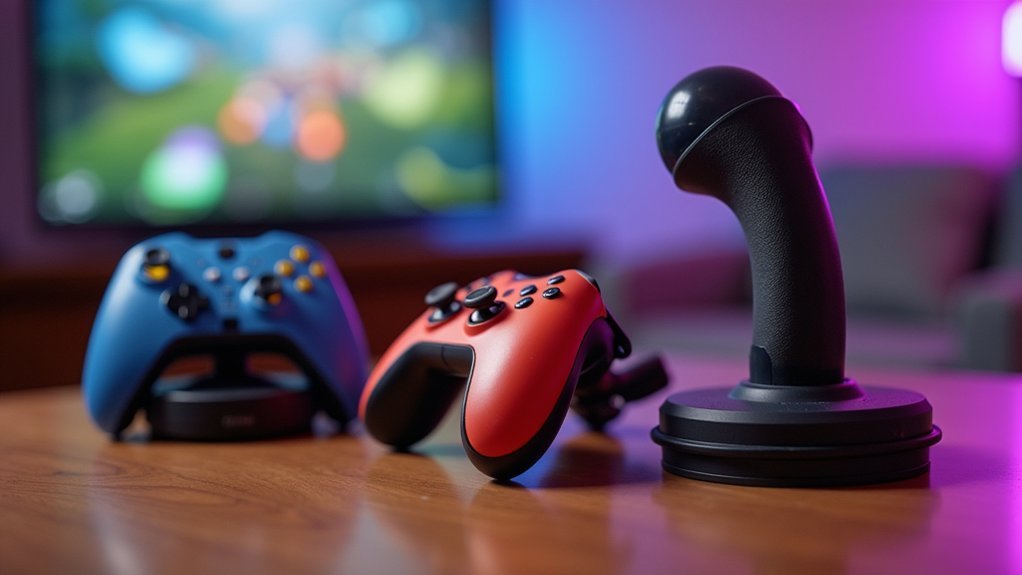For cerebral palsy gamers, the top interfaces include the Xbox Adaptive Controller with extensive customization, PlayStation Access Controller’s flexible pod design, the therapeutic GiocAbile System, large external buttons for limited motor skills, head-operated controls for hands-free play, sip-and-puff controllers for breath-based inputs, and foot pedals for those with lower extremity control. You’ll discover how these technologies can transform frustrating gaming experiences into enjoyable, therapeutic activities with the right personalized setup.
Xbox Adaptive Controller: Customization for CP Gamers

While traditional gaming controllers present significant challenges for users with cerebral palsy, the Xbox Adaptive Controller offers unprecedented customization options designed specifically for diverse mobility needs.
The Xbox Accessories app lets you completely remap any button to match your specific abilities. You can create custom profiles for different games, adjust joystick sensitivity, and even map complex actions to single buttons.
Complete control in your hands—customize every button, sensitivity, and action to work with your body, not against it.
For CP gamers with visual processing difficulties, you’ll appreciate the ability to assign accessibility features like color filters and high contrast mode to easily accessible buttons. If you encounter setup problems, Xbox Support provides comprehensive troubleshooting assistance tailored to adaptive controller configurations.
What sets this controller apart is its compatibility with specialized third-party devices. You can connect external joysticks, switches, and mounts that accommodate your unique movement patterns, creating a truly personalized gaming setup tailored to your specific cerebral palsy symptoms.
PlayStation Access Controller: Flexibility for Various CP Mobility Levels
Unlike previous controllers, the PlayStation Access Controller has revolutionized gaming for cerebral palsy users through its thoughtful circular pod design.
You’ll find eight customizable buttons around the perimeter with a large central button for easier access.
The controller adapts to your specific mobility needs with its adjustable joystick orientation and interchangeable button caps.
You can choose from pillow caps, flat caps, or overhang caps based on your dexterity level.
With four expansion ports, you can connect additional switches or joysticks to create your ideal setup. These industry-standard 3.5mm AUX ports support third-party accessories without requiring PlayStation licensing.
The non-slip base and mounting capability let you secure it to surfaces like wheelchairs or tables.
For complete functionality, pair it with another Access controller or a standard DualSense, allowing flexible play styles suitable for various CP mobility levels.
GiocAbile System: Specialized Design for Cerebral Palsy Therapy

The GiocAbile System represents a specialized interface explicitly developed for therapeutic applications among cerebral palsy users. This innovative platform, whose name combines the Italian words for “play” and “able,” integrates both software and custom hardware components—including the PhiCube sensor and PlayCuff controller.
You’ll find GiocAbile uniquely accommodates diverse positioning needs, allowing gameplay while seated, standing, or in a wheelchair. The system’s PC compatibility makes it accessible in both clinical and home environments, with configurations adjustable to your specific mobility capabilities. Similar to REHAB-PAL, it aims to enhance adherence to home exercise regimens through engaging interactive elements.
What sets GiocAbile apart is its dual focus on rehabilitation and enjoyment. Each one-hour play session encourages therapeutic movements within an engaging context, making prescribed exercises more motivating.
Pilot studies confirm high acceptability across various CP impairment levels, with positive ratings for usability and enjoyment.
Large External Buttons: Simplified Access for Limited Motor Control
Large external buttons provide revolutionary accessibility for gamers with cerebral palsy, especially those managing limited motor control. You’ll find these buttons designed with substantial surface area, allowing activation with any body part—elbows, fists, or forearms—without requiring fine motor skills. The Xbox Adaptive Controller offers extensive customization options that perfectly complement these large-button interfaces for a complete accessibility solution.
| Feature | Benefit |
|---|---|
| Large surface area (2-4 inches) | Reduces need for precision movements |
| Programmable functionality | Customizable for different games and needs |
| Textured/colored surfaces | Provides helpful visual and tactile feedback |
The impact goes beyond gameplay. Users report increased confidence, reduced frustration, and decreased hand fatigue during extended sessions. With Xbox Adaptive Controller and similar products, you’re able to store multiple button profiles and integrate third-party switches, making mainstream gaming accessible while fostering inclusion in online communities.
Head-Operated Controls: Gaming Without Hand Movement

Moving beyond physical button interfaces, head-operated controls represent a revolutionary approach for gamers with cerebral palsy who’ve limited or no hand movement capabilities.
These systems enable you to participate in gaming experiences through controlled head movements, particularly beneficial if you have dystonic quadriplegic cerebral palsy.
Custom-contoured designs adapt to your specific needs, with many incorporating sensory feedback through visual or auditory cues.
Every head-operated interface is uniquely shaped to your requirements, offering sensory responses that guide your gaming experience.
You’ll find these controls often feature one-button functionality and simple navigation options that make gaming more accessible.
Beyond entertainment, these interfaces offer therapeutic benefits by supporting cognitive development and motor therapy.
Jake’s experience with Nintendo Switch titles demonstrates how these accessible controls help create enjoyable gaming sessions that include family participation too.
Many systems now include multiplayer options, enhancing your social interaction opportunities.
With collaborative development involving actual users, today’s head-operated controls continue to evolve with your comfort and abilities in mind.
Breath and Foot Controls: Alternative Gaming Interfaces for Severe CP
When you can’t rely on hand or head movements, breath-controlled sip-and-puff devices and foot pedal systems offer powerful gaming alternatives for severe CP.
You’ll find these technologies range from simple pneumatic switches that register inhaling and exhaling patterns to adjustable foot pedals that can be positioned for ideal access.
Combining multiple control methods—such as a sip-and-puff device for primary actions and foot controls for secondary functions—can create a customized gaming experience that matches your specific abilities and comfort. These adaptive interfaces complement traditional therapy by transforming repetitive therapeutic movements into engaging game experiences that children perceive as fun rather than medical intervention.
Sip-and-Puff Technology Explained
Several innovative assistive technologies have emerged for gamers with cerebral palsy, but sip-and-puff systems stand out for those with severe motor limitations. These devices convert your breath actions into digital commands – sipping (inhaling) or puffing (exhaling) through a tube generates air pressure signals that control electronic devices.
You can customize these systems to perform different actions based on the intensity and duration of your breath inputs. For gaming, sip-and-puff controllers translate these signals into in-game actions, allowing you to navigate menus, control characters, and engage with virtual worlds. They’re compatible with specialized gaming software that supports switch access. The technology originated from Bill Cameron’s invention for Neil Squire that translated sips and puffs into Morse code.
Low-tech options like TubusOne offer affordable alternatives for touchscreen interactions, while integration with Tecla equipment enhances versatility by connecting with various assistive technologies and environmental control systems.
Foot Pedals: Setup Guide
For gamers with cerebral palsy who maintain some lower extremity control, foot pedals represent an accessible and versatile gaming interface option.
Setting up these devices requires minimal technical knowledge, though custom configurations may demand more expertise.
Position your pedals at shoulder width for ideal comfort and control. If you’re gaming on hardwood or tile, you’ll need to secure the pedals to prevent slipping—carpeted surfaces naturally provide better stability.
Many models offer customizable button assignments to match your specific needs and abilities. Some designs feature a center ground circle for consistent heel placement, providing a stable reference point during gameplay. For enhanced accessibility, consider integrating foot controls with breath-operated devices, creating a thorough control system that accommodates your unique capabilities.
The Xbox Adaptive Controller works seamlessly with foot pedals, offering additional customization through its specialized ports and mapping software.
Combining Control Methods
Gamers with severe cerebral palsy often benefit most from integrated control systems that combine multiple input methods. Breath and foot control combinations offer a powerful alternative that leverages different motor abilities simultaneously, allowing you to overcome individual limitations. Traditional treatments for cerebral palsy require intense, repetitive exercises to promote neuroplasticity, making these alternative interfaces particularly valuable.
- Breath sensors detect inhalation/exhalation patterns for triggering in-game actions
- Foot controls capture pressure shifts when fine motor skills are limited
- Customizable sensitivity settings accommodate your unique abilities
- Color-change feedback mechanisms enhance your motor learning
- Synchronized inputs process different signals simultaneously for seamless gameplay
This multi-modal approach maintains high motivation during therapy sessions while stimulating neuroplasticity.
Creating a Personalized Gaming Station for CP Users
Creating a personalized gaming station that meets your unique needs as a cerebral palsy user can transform gaming from a frustrating experience into an enjoyable and accessible activity.
Start by exploring user profiles from the Cerebral Palsy Foundation to identify which switches and setups might work best for your specific abilities.
Research first, choose wisely—your perfect gaming setup begins with understanding what works for others with similar abilities.
Take advantage of consultation services offered by accessibility organizations to design your ideal setup. Look for games with accessibility tags from the Accessible Games Initiative to guarantee they’ll work with your equipment.
Consider incorporating a hub like the Xbox Adaptive Controller or Hori Flex Controller as your foundation, then customize with specialized switches that match your movement capabilities. The Xbox Adaptive Controller was designed with input from the Cerebral Palsy Foundation to ensure it addresses diverse physical abilities.
Don’t hesitate to connect with online communities where you can view others’ successful configurations and share your own experiences.
Frequently Asked Questions
How Much Do Adaptive Gaming Systems Typically Cost?
Adaptive gaming systems typically cost between $99.99 to $179 for basic options like the Xbox Adaptive Controller, while high-end customized solutions can be considerably more expensive depending on your specific needs.
Are Adaptive Controllers Covered by Insurance or Assistance Programs?
Typically, insurance doesn’t cover adaptive controllers as they’re considered leisure devices rather than medical necessities. However, you can seek help through organizations like The AbleGamers Charity that offer financial assistance for gaming equipment.
Can Children With CP Play Multiplayer Games With Non-Disabled Friends?
Yes, you can play multiplayer games with non-disabled friends through adaptive technologies like CoPilot controllers. These solutions enable co-gaming experiences, fostering social interaction while allowing you to participate equally in gaming communities.
What Gaming Genres Work Best With Adaptive Controllers?
You’ll find turn-based strategy games work best with adaptive controllers, followed by adventure and puzzle games. With proper button remapping, you can also enjoy simulations and even some action games with practice.
How Long Does It Take to Learn Adaptive Gaming Interfaces?
You’ll typically learn adaptive gaming interfaces within a few sessions if you’re tech-savvy, but mastery varies based on interface complexity, your experience level, and how consistently you practice with the customized controls.
In Summary
You’ve now got the tools to break down gaming barriers. Whether you’re using adaptive controllers, specialized buttons, or breath controls, these interfaces create a pathway to gaming enjoyment regardless of your CP mobility challenges. Remember, the perfect setup is personal—mix and match these solutions to create your ideal gaming environment. Don’t let cerebral palsy keep you from the games you love.





Leave a Reply